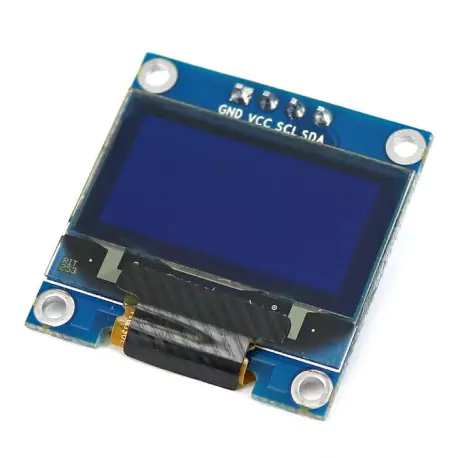What is OLED Display Module?
OLED Display Module (Organic Light-Emitting Diodes) is a flat light emitting technology-based screen.
OLED represents an advanced display technology constructed from a thin film of light-emitting organic materials.
When electrical current flows through it, OLED emits a bright light.
OLEDs are emissive displays that do not require a backlight and so are thinner and more efficient than LCD displays (which do require a white backlight).
OLED displays are not only thin and efficient, but they also offer the best image quality compared to LED and LCDs. Additionally, manufacturers can create them to be transparent, foldable, flexible, and potentially even rollable and stretchable in the future.
OLEDs represent the future of display technology!

Specifications
- OLED is an organic light-emitting diode that emits light in response to an electric current.
- The OLED display module (SSD1306) is one of the most attractive displays available for a microcontroller. It has a good view angle and pixel density which makes it reliable for displaying the small level of graphics. You can interface this IC with an MCU using either I2C or SPI, which helps save some pins as well.
- OLED is an organic light-emitting diode that emits light in response to an electric current. The OLED display can works with no backlight so it can display deep black levels. It is small in size and light in weight than Liquid Crystal Displays (LCD).
- 128×64 OLED display is a simple dot-matrix graphics display system. The OLED display has 128 columns and 64 rows which make it a display of total 128×64 = 8192 pixels. By just turning on or off these pixel’s led we can display a graphical image of any shape on it.
- The OLED display actively displays text, images, and various types of patterns. It is also suitable for mobile phones sub-display, MP3 players, calculators, etc.
- The OLED display has 256 steps for brightness control and, it is also available with a different resolution like 128×32, 128×64.
Related Articles:
Pin Configuration
| Pin Name | Description |
|---|---|
| Ground (GND) | Connected to the ground of the circuit |
| Vcc (Vdd,5V) | Can be powered by either 3.3V or 5V |
| SCL (D0,CLK) | It is a clock signal. This pin transmits clocks to a slave, SCL. Data will be sent to other devices on clock tick event. The only master device has control over this SCL line |
| SDA (D1,MOSI) | SDA is used to transmit data between master and slave. The data and acknowledgement are sent through SDA. |
Features of OLED Display
- Monochrome 7-pin SSD1306 0.96” OLED display.
- 128×64 pixel resolution with 160° viewing angle.
- Supply voltage 3V – 5V (supports both 5V and 3.31v logic devices).
- It uses SSD1306 for interfacing hence can communicate through SPI or IIC.
- It supports multiple SPI or I2C devices.
- You can easily interface it with Arduino (Library available).
- Supports decent graphics of bitmap images.
Other Types of OLED Display Modules
| S.No | Classification | Types |
|---|---|---|
| 1 | Based on Colour | Monochrome(Blue) |
| Monochrome(White) | ||
| Yellow/Blue Colour | ||
| 2 | Based on number of Pin | 3-Pin (supports only IIC) |
| 7-Pin (supports IIC and SPI) | ||
| 3 | Based on interface IC | SSD1306 |
| SSD1331 | ||
| 4 | Based on size | 0.91” (128×32) |
| 0.96” (128×64) |
Applications
- Used in consumer electronics.
- Used for Smartwatch, mobile phone, and MP3 displays.
- Small level gaming displays.
- Its wide range of viewing angles enables it to function effectively in low light.